Archive for ‘Productivity’ Category
Celebrate the Global Day of Unplugging
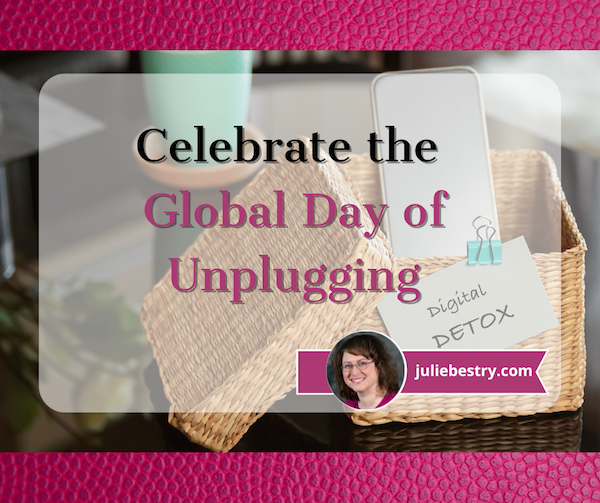
From the moment you open your eyes in the morning until you finally nod off at night, do you experience over-stimulation? Do you suffer from over-availability, whether to your boss, colleagues, or clients, or to everyone who wants to talk to you about their political campaigns or your auto warranty?
Even if you’re overly connected with the world via glass screens, do you feel a lack of connection — with your loved ones, nature, or even your inner self?
Have I’ve got a holiday for you! From sundown this Friday, March 1, 2024 until sundown on Saturday, it is the Global Day of Unplugging!
WHAT IS THE GLOBAL DAY OF UNPLUGGING?
The Global Day of Unplugging is an annual campaign to bring attention to the importance of taking a break from 21st-century technology, whether that’s your computer, your cell phone, or your brand new Apple Vision Pro. The goal is to embrace person-to-person connection, the kind where you can see deeply into someone else’s eyes because you’re in the same space at the same time.

It’s not that digital engagement is bad, per se. Zoom meetings and remote work means we reduce our overall carbon footprint from work-related road trips and airline travel. Cell phones (even if people mostly communicate by text) let us know when our friends are running late or if the kids need someone to pick them up.
But being on-all-the-time keeps us from ever refreshing. When it’s our boss that keeps us connected, that’s toxic, as we’ve discussed previously:
- Toxic Productivity In the Workplace and What Comes Next
- Toxic Productivity Part 2: How to Change Your Mindset
- Toxic Productivity Part 3: Get Off the To-Do List Hamster Wheel
- Toxic Productivity, Part 4: Find the Flip Side of Productivity Hacks
- Toxic Productivity Part 5: Technology and a Hungry Ghost
I mean, we could move to France, as covered in the first post above, or to Australia, which has just voted to allow workers to ignore after-hours phone calls and email from their companies. That could help reduce any employer-related tethering to our devices.
But we do this same damage to ourselves! Like a digital pacifier, we reach for our devices when we’re bored or anxious: in line at the grocery store, waiting for a doctor’s appointment, on the other end of the couch from our kids or significant other.
Technology is pushed on us from above and from all sides, but it has the potential to become an addiction that pushes us further away from our loved ones.
Wouldn’t you benefit from a little escape? For one 24-hour period starting on Friday, people from all four corners of the globe (yes, I know globes have no corners), will intentionally walk away from their digital lives and meet IRL (in real life).
WHY UNPLUG?
Let’s look at the dangers of the attention economy, which treats our eyeballs (attention) as a scarce commodity. We can prevent some of the problems by decluttering our digital spaces; other parts require concerted efforts at unplugging.
Distractions
Our computers and devices bring so much digital clutter to our attention. Some of it involves what other people want us to pay attention to, things we may or may not find important. But other distractions we bring on ourselves by clicking our way into deeper and deeper rabbit holes, directing us to an article online or a video on TikTok, but then we stay, enraptured and forget what we were doing.
These distractions take our focus off where we intend it to be. Intention is how we make sure we handle what we prioritize and not someone else’s priorities. Decluttering minimizes those distractions.
When we’re organized in our homes or offices, the clutter and inefficient systems make it hard to find what we want when we want it. Digital clutter is more insidious because we don’t even realize that we’re being distracted — we’ve become so used to it, and because nobody else sees our digital clutter they don’t call attention to it.
When we eliminate digital excess and distractions and create new, more efficient pathways, we feel calmer and more in control. When that happens, we’re in the zone, better able to do deep work and get into flow, with less wasted time searching for whatever we want — or what our boss or client wants.
However, of all the ways digital addiction hurts us, perhaps the distractions and lack of productivity are the least important.
Physical Health
Digital overuse is bad for our physical health. We develop bad posture from shlumping at our desks, gripping our phones, and hyperextending our necks.
Tech Neck is an informal term for the medical condition we experience when we use our devices. We flex our necks and shoulders, causing strain strain on the muscles and joints; the more we do it, the greater the build-up of tension, leading to muscle pain and headaches. Some research even suggests that overusing mobile devices can cause bone spurs to form at the nexus between the neck and head!
Additionally, exposure to the blue light emitted by phones, tablets, and computer screens can cause insomnia and decrease the quality of our sleep, which can further impact our ability to focus. Of course, when our attention span is decreased (whether due to sleepless nights or being trained to think in tweet-length chunks of language), it takes ever more effort to interpret complex material or be creative.
And, of course, repeated digital interruptions from our devices leads to higher rates of exhaustion and stress-induced ailments.
Stress
Speaking of stress, staying plugged in messes up our psyches in multiple ways:
- Information overload leads to overwhelm — To borrow a movie title, it can seem like we’re dealing with everything everywhere all at once. Your work, your children’s homework portal, national disasters, politics — it’s all so important.
The problem with everything seeming like a priority is that eventually nothing is a priority. All issues, large and small, compete on a stage the size of the planet, the form of your smartphone, and the synapses in your brain simultaneously.
The problem with everything seeming like a priority is that eventually nothing is a priority. All issues, large and small, compete on a stage the size of the planet, the form of your smartphone, and the synapses in your brain… Click To Tweet- Overwhelm leads to increased anxiety — Think about the last time you were trying to juggle multiple problems at the same time. I bet you were trying to give your attention to so many interested parties that one last, small request (“Honey, where’s the Costco card?” “Mom, can you take me to the mall?”) made you feel like your limbs where going to fly off in different directions.
- Use of social media leads to a variety of emotional dysfunctions. Over the last decade, social media use has grown; in 2022, the average person spent 2 hours and 27 minutes on social media per day. Why is that worrying?
- The more we connect online, the more we experience FOMO (fear of missing out).
- We more see other people having fun (attending parties, going on vacation, celebrating life milestones), the more likely we are to feel lonely.
- Comparing one’s own life to other’s highlight reels can lead to lower levels of self-esteem. If you judge your own self-worth by comparing yourself to others, social media may make you feel like you’re failing.
- As people — particularly younger folks — spend less time developing in-person social interactions and more time on social media and dating apps, there’s an increase in social awkwardness when they finally do meet face-to-face. This contributes to more social anxiety. Additionally, the social relationships we do have tend to fray without positive, in-person interactions.
- Social media makes it easier for people to exhibit bad behavior. Bullied teenagers used to have a respite from their cruel classmates once the school day was over; now, it follows them home on their phones and social gaming sites. And we all know about rude online treatment of anyone who dares to have a differing opinion on anything, whether politics, sports, or music, or has a different religious, national, ethnic, or other kind of identity.
- More nuanced unkindness online occurs in the withholding of likes or social approval, which again, when we compare our “performance” and “appeal” to that of others, can make us feel like we’re lacking.
- All of this can lead to depression.
- We can lose the ability to ability to self-soothe when we’re constantly tethered to our digital pacifiers. On the plus side, our devices can distract us from very real things that, well, suck. But when we become dependent on that kind of distraction, our former life skills dissolve. We used to be able to make polite conversation with strangers in line or read books for extended periods of time. We could go to sleep without an hour of scrolling. Now, we’re often unable to tame our thoughts unless we allow the internet to do it.
WHY IS IT SO HARD TO UNPLUG?
Every app and the whole on the internet is purposely designed to keep you coming back.
There’s a scientific explanation. Every time we use our devices, it reinforces the pathways taken by dopamine, a happy-making neurotransmitter at the base of our reward-seeking behaviors. Just like the bells and blinking lights on a Vegas slot machine condition us to pull the lever or push the buttons one more time, the notifications, “Breaking News” headlines, daily streaks in apps, and aforementioned “likes” draw us back in.
Worse, as with other addictions, when this neurotransmitter pathway doesn’t get reinforced, we actually experience something very similar to a chemical withdrawal. Have you ever found yourself without your phone, feeling jittery and unable to tame your mood?
It’s not your fault. You have to use modern devices for work, and you really do want to have access for many of life’s convenience. But you will feel better if you can lessen your dependence.
HOW TO UNPLUG FOR A DAY
To celebrate the Global Day of Unplugging, you can look for a community event near you. There’s everything from a musical chairs event in Charleston to Yoga and Sound Healing in Gainesville, from a Family Bonfire & S’Mores in Star, Idaho to something called a Disco Get Down-Dog in San Diego. And this truly is global, with events from Denmark to Bolivia, Virginia to Switzerland!
The Global Day of Unplugging organization has listed over 200 ideas of what you can do instead of being plugged in!
The idea isn’t to become a Luddite, but to find ways to feel less isolated or disconnected (whether from others or yourself). Ideas range from the tame (unclutter your pantry, take a hike, do some gardening) to those that indulge your inner child (build a living room fort, blow bubbles, put on a puppet show).
Create art (decorate a lantern, have fun with origami) or go on a quest (create a scavenger hunt or go on a Gnome hunt)! And while I’d be hopeless at crocheting for a cause or going on an ice-block slip & slide, all of these events would definitely be healthier for my brain, heart, and soul than scrolling through the curated slime-fest some platforms have become.
You can also support the global unplugging movement by making a donation or purchasing “merch,” but even joining at the free plan lets you download their “I/We Unplug” signs.
If you enjoy the Global Day of Unplugging, consider taking a tech sabbath as described by Tiffany Shlain in 24/6: Giving up Screens One Day a Week to Get More Time, Creativity, and Connection or doing a digital detox on a more regular basis, so you and your devices take a real break from one another.
24 Smart Ways to Get More Organized and Productive in 2024
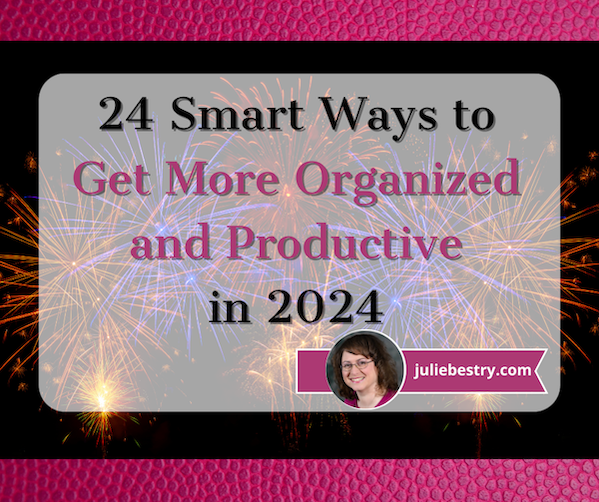
Happy New Year! Happy GO Month!
January is Get Organized & Be Productive (GO) Month, an annual initiative sponsored by the National Association of Productivity & Organizing Professionals (NAPO). We professional organizers and productivity experts celebrate how NAPO members work to improve the lives of our clients and audiences by helping create environments that support productivity, health, and well-being. What better way to start the year than creating systems and skills, spaces and attitudes — all to foster a better way of living?!

To start GO Month, today’s I’m echoing Gretchen Rubin’s 24 for ’24 theme that I mentioned recently, and offering you 24 ways to move yourself toward a more organized and productive life in 2024. There are 23 weekdays in January this year, so if you’re feeling aspirational and want to conquer all of these, you can even take the weekends off as the last item is a thinking task rather than a doing task.
I broke these organizing and productivity achievements down by category, but there’s no particular order in which you need to approach them, and certainly you don’t need to accomplish every one on the list, in January or even all year. Jump in and get started — some only take a few minutes.
PUT LAST YEAR AWAY
1) Make many happy returns!
Did you know that shoppers will return $173 billion in merchandise by the end of January? Chances are good that you (or someone for whom you oversee such things) got gifts that need to be returned.
Don’t put it off. The longer you wait, the more clutter will build up in your space, and the more likely you will be to suffer clutter-blindness until the return period has expired. Most stores have extended return policies during the holidays, but they can range upward from 30, depending on whether you have a gift receipt.
The Krazy Coupon Lady blog reviews the 2024 return deadlines for major retailers. She notes that you’ll get your refunds faster by returning items to the brick & mortar stores rather than shipping them back. You’ll also save money, because some online retailers charge a restocking fee.
2) Purge your holiday cards.
While tangible greeting are getting fewer and farther between, you probably still got a stack. Reread them one last time, and then LET THEM GO.
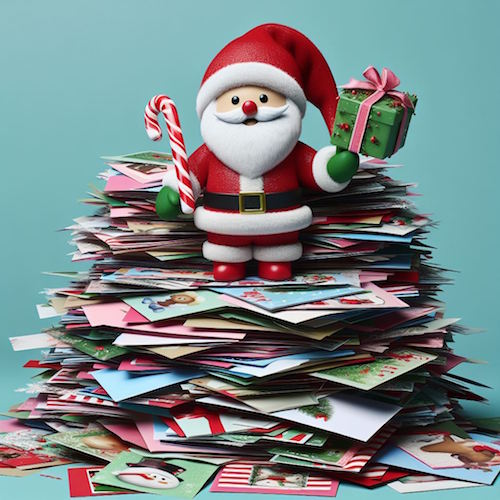
Did Hallmark or American Greetings do the heavy lifting, and the senders just signed their names? Toss them into the recycling bin. Paper Doll‘s grants you permission to only save cards with messages that are personal or resonant.
If they don’t make you cry, laugh, or go, “Ohhhhh,” don’t let them turn into the clutter you and your professional organizer will have to toss out years from now when you’re trying to downsize to a smaller home! It’s a holiday message, not a historical document; you don’t transcribe your holiday phone conversations and keep them forever, right?
The same goes for photos of other people’s families. You don’t have to be the curator of the museum of other people’s family history; let them do that.
3) Update your contacts.
Before you toss those cards, check the return addresses on the envelopes and update the information in your own contacts app, spreadsheet, or address book.
Next, delete the entries for people you’ll never contact again — that ex (who belongs in the past), that boss who used to call you about work stuff on weekends (ditto), people who are no longer in your life, and those who are no longer on this mortal coil.
If you don’t recognize the name of someone in your contacts, Google them or check LinkedIn (is it your mom’s doctor? your mechanic?) and if you still don’t know who it is, you’re obviously not going to be calling or texting them. Worst case scenario, if they text you, you can type back, “New phone, who dis?”
BOX UP YOUR INBOXES
4) Delete (most of) your old voicemails.
How often do you return a call only to hear, “The voicemail box is full and is not accepting messages. Please try again later.” When someone calls you and requests you call them back but their voicemail is full, it’s frustrating because it makes more labor for you.
Do you assume that it’s a cell phone and text them? (I believe texting strangers without permission is a breach of etiquette.) Plan to call back later? Assume that they’ll see the missed call and get back to you, starting another round of phone tag? ARGH!
Dial in to your voicemail and start deleting. Save phone numbers for anyone you’ll need to contact and log anything you may need to follow up on. But unless you’re saving a voicemail for legal purposes or because you can see yourself sitting in an airport, listening to a loved one’s message over and over (cue sappy rom-com music), delete old voicemails.
If you’ve got a landline, clear that voicemail. If you’ve still got an answering machine, how’s the weather in 1997? Yeah, delete old messages.
Smith.ai has a great blog post on how to download important voicemails (from a wide variety of phone platforms) to an audio file. Stop cluttering your voicemail inbox!
5) Clear Your Email Inboxes
Start by sorting your inbox by sender and deleting anything that’s advertising or old newsletters. If you haven’t acted on it by now, free yourself from inbox clutter! Delete! Then conquer email threads, like about picking meeting times (especially if those meetings were in the past).
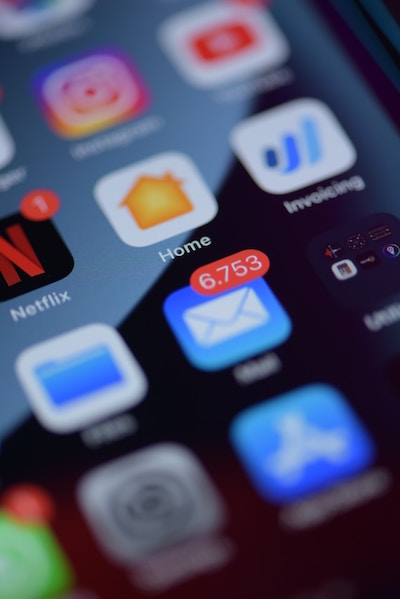
Take a few minutes at the end of each day to delete a chunk of old emails. To try a bolder approach, check out a classic Paper Doll post from 2009, A Different Kind of Bankruptcy, on how to declare email bankruptcy.
6) Purge all of your other tangible and digital inboxes.
Evernote has a default inbox; if you don’t designate into which folder a saved note should go, your note goes somewhere like Paper Doll‘s Default Folder. Lots of your note-taking and other project apps have default storage that serves as holding pens. Read through what you’ve collected — sort by date and focus on the recent items first — and either file in the right folders or hit delete!
Walk around your house or office and find all the places you tend to plop paper down. Get it in one pile. (Set aside anything you’ll absolutely need in the next few days to safeguard it.) Take 10 minutes a day to purge, sort, and file away those random pieces of paper so that you always know where they are.
HIT THE PAPER TRAIL
7) Embrace being a VIP about your VIPs.
You need your Very Important Papers for all sorts of Very Important Reasons. If the last few years have proven anything, it’s that life is unpredictable, so we need to find ways to make things as predictable and dependable as possible.
Yes, putting together essential paperwork isn’t fun. It’s boring. But you want it to be boring. The more boring your vital documents are, the more it means there will be no surprises for your loved ones in troubling times (like during and after an illness, after a death, while recovering possessions after a natural disaster) or even when you’re just trying to accomplish something like getting on an airplane.
Start with these posts, then make a list of any document you already have (and where it is), and another list of what you need to create, and plan meetings with your family and a trusted advisor to set things in motion.
How to Replace and Organize 7 Essential Government Documents
How to Create, Organize, and Safeguard 5 Essential Legal and Estate Documents
The Professor and Mary Ann: 8 Other Essential Documents You Need To Create
Paper Doll’s Ultimate Guide to Getting a Document Notarized
Paper Doll’s Ultimate Guide to Legally Changing Your Name
A New VIP: A Form You Didn’t Know You Needed
8) Create your tax prep folder now so you’ll be ready for April 15th.
Do you toss non-urgent mail on top of the microwave? Might those important 1099s and 1098s and 1095-A and W-2s get lost? Don’t lose deductions, pay more taxes, or get in trouble with the IRS!
By the end of January, you’ll start getting tax documents in the mail. Pop them in a folder in your financial files or in a dedicated holder like the Smead All-in-One Income Tax Organizer.
Recapping Paper Doll’s 2023 Posts — Which Were Your Favorites?
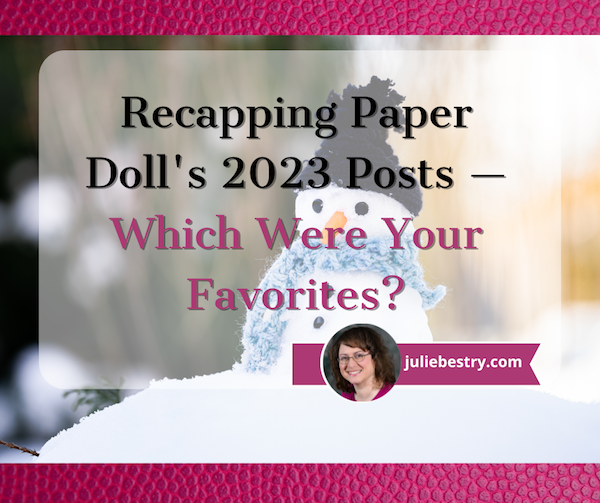
With one week left in 2023, have you taken time yet to review your year?
For the December Productivity and Organizing Blog Carnival, Janet Barclay asked us to identify our best blog posts of 2023, and I had a tough time.
“Best” is subjective, and Janet let us have free reign as to which post fit. Some bloggers chose their most popular posts in terms of readership; others, the ones that garnered the most comments. Some of my blogging colleagues picked their most personal posts, while others selected what they felt would have the most impact on people’s lives.
The problem is that picking just one means leaving the others behind, and I wrote forty-two posts this year! Eventually, I narrowed the selection to half a dozen posts, and then turned to colleagues and friends who were almost evenly split, bringing me no closer to a solution. In the end, I picked Paper Doll On Understanding and Conquering Procrastination because it served as the foundation for so many other posts, but also because I’d been lucky enough to find some great visuals, like this one from Poorly Drawn Lines:
so much to do pic.twitter.com/fiSm7Y2Erg
— poorly drawn lines (@PDLComics) December 21, 2022
Beauty, like clutter, is in the eye of the beholder. To that end, here’s a recap of everything we’ve discussed in 2023, with a few updates and tweaks along the way. My personal favorites are in bold, but I’d love to know which ones resonated the most with you during the year!
ORGANIZE YOUR INSPIRATION
After uploading last week’s post, Toss Old Socks, Pack Away 2023, and Adjust Your Attitude for 2024, I got to thinking about all the different ways we can take our word, phrase, or song of the year and keep it in the forefront of our minds.
I’d reviewed the traditional methods (vision boards, posted signs, turning the song into your wakeup alarm), but felt like there needed to be something that stayed with you, independent of your location. Only being reminded of your goal to be a leader when you’re standing in front of your fridge doesn’t really help you in your 1-to-1 meetings at work. (I mean, unless you’re the Queen of the Condiments or King of the Crisper Drawer.)
Only being reminded of your goal to be a leader when you're standing in front of your fridge doesn't really help you in your 1-to-1 meetings at work. (I mean, unless you're the Queen of the Condiments or King of the Crisper Drawer.) Click To TweetSerendipitously, within minutes of thinking about this, an ad came across one of my social media pages. (Normally, I ignore ads, but this one had me thinking maybe “serendipity” would be a good theme word for some year!) The ad was for Conscious Ink, an online temporary tattoo retailer specifically for creating body art to help you mindfully connect with your themes and messages to yourself, disrupt negative self-talk, and promote the healthy habits you’re trying to embrace!
As Conscious Ink’s About page explains, if you want to keep something top of the mind, why not try something that keeps it “top of the body?” Whether body art is your thing or you haven’t experimented since your Minnie Mouse temporary tattoo at summer camp <mumble mumble> years ago, this is a neat trick!
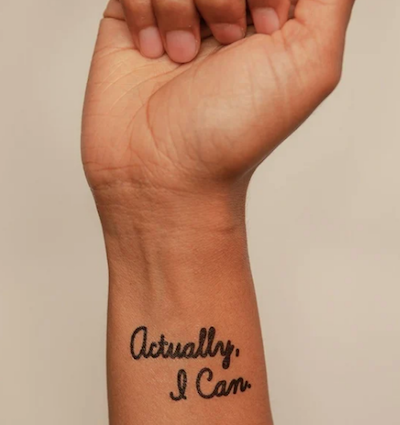
There’s even research as to how a temporary tattoo can support permanent emotional and cognitive transformation and improve mindfulness and focus on things that uplift one’s higher self. And that’s the point of a theme word, phrase, or song, to keep you focused on what you want rather than what you allow to drag you down! Manifest what you want your life to be.
Conscious Ink’s temporary tattoos use non-toxic, cosmetic-grade, FDA-certified, vegan inks. Each one lasts 3-7 days, depending on where you apply it, your skin type and activity level, and (I suspect) how many life-affirming, stress-reducing bubble baths you take. Categories include mindset, health and wellness, spiritual/nature, relationships, parenting, celebratory, and those related to social causes. Prices seem to hover at around $10 for a three-pack and $25 for a 10-pack. There’s even a Good Karma Guarantee to make sure you’re satisfied.
Whether you go with Conscious Ink (which is designed for this uplifting purpose) or seek an alternative or custom-designed temporary tattoo (through vendors like Momentary Ink or independent Etsy shops), it only makes sense if you place it somewhere you can see it often.
After all, if you place a temporary tattoo reminder to stand up for yourself on your tushy, it probably won’t remind you of much. For most of us of a certain age, putting it at our wrists, covered (when we prefer) by our cuffs, will give us the most serene “om” for our buck.
If you place a temporary tattoo reminder to stand up for yourself on your tushy, it probably won't remind you of much. Click To TweetAlong the same lines as my advice on adjusting your attitude for 2024, you may want to consult Gretchen Rubin’s Tips for Your “24 for 2024” List. Rubin and her sister/podcast co-host always have an inspring Happier Trifecta: a year-numbered theme, along with with a challenge and a list.
PRODUCTIVITY AND TIME MANAGEMENT
This was a big year for productivity discussion. I’m a firm believer that keeping your space and resources organized is key to being productive. However, it’s hard to keep the world around you organized when outside influences prevent you from being efficient (doing things well) and effective (doing the right things).
We continue to see the value of body doubling, whether through friendly hang-outs, co-working (virtually or in person), or professional organizing services, whether you want to conquer garden-variety procrastination or get special support for ADHD.
Partnering for Success
Paper Doll Sees Double: Body Doubling for Productivity (I almost submitted this post to the carnival. Accountability and motivation for the win!)
Paper Doll Shares 8 Virtual Co-Working Sites to AmpUp Your Productivity
If you’d like to explore the body doubling or co-working experience, friend-of-the-blog Deb Lee of D. Allison Lee is offering a no-cost, two-hour Action Day event on Tuesday, January 9, 2024, from 10 a.m. to 12 p.m.

This event is designed for her clients and subscribers, but after a cheery holiday conversation, Deb said it was OK to let my readers know about the opportunity.
Deb describes an Action Day as “personal training for your productivity muscles!”
An Action Day (especially as Deb runs them) is a stellar way to narrow your focus and start taking action on your goals. (And what better time than at the start of the new year?) You’ll get to connect with others who are also working on goals and habits with the support of Deb, a productivity coach I admire and adore.
Just bring your top two or three priorities, and you can conquer anything, like:
- organize your workspace
- write your book outline
- clean up your digital files
- test a new productivity app
- send out client proposals
- anything!
You’ll videoconference with a small, select group via Zoom. Share your goal and tasks, work for the bulk of the two hours, and then take time to debrief and share your successes!

Moving Yourself Forward
Getting anything done involves figuring out what you have to do, knowing what’s kept you from getting started, making it easy for you to begin, and celebrating even the smallest wins. These next three posts were where the magic happened this year!
Paper Doll On Understanding and Conquering Procrastination (This is the post I submitted to the Productivity & Organizing Carnival.)
Frogs, Tomatoes, and Bees: Time Techniques to Get Things Done
Use the Rule of 3 to Improve Your Productivity
Dealing with the Pokey Times
If you’re overwhelmed by all you’ve got going on during late December and early January, you can skip onward. However, if your workplace closes down during the holidays, or your professional and personal lives just feel like they’re kind of in a slump right now, you may find some inspiration in two pieces I wrote for the summer slowdown.
The weather outside may be frightful (unless you’re reading from Australia), but if you are looking for ideas to pump you up when everyone is in a post-shopping/meal/travel haze, these posts may stir your motivation:
Organize Your Summer So It Doesn’t Disappear So Quickly
Use Your Heart, Head, and Hands to Organize During the Slow Times
Try To Do It All (And Knowing When to Step Away)
Maybe you did your annual review and found that you’re feeling burned out. If so, you are not alone. It’s easy for your groove to turn into a rut, and for all of your drive to accomplish come crashing down because you never take your foot off the gas all year!
If you missed these posts earlier need a second shot at embracing the importance of variety, small breaks, and actual vacations, here’s your chance to read some of my absolute favorite posts of the year:
Paper Doll Says: Don’t Get Stuck in a Rut — Take Big Leaps (Be sure to watch the diving board video!)

Was baby Paper Doll burned out? In a rut? Just pooped?
Take a Break — How Breaks Improve Health and Productivity
Take a Break for Productivity — The International Perspective (This is the post that introduced the Swedish convivial snack break, fika!)
If you had any doubts about what I said about the importance of taking breaks in your day to refresh your body, your brain, or your spirit, a new report just a few weeks ago confirms that we need that late afternoon break if we don’t want our productivity to turn to mush! And the more we push ourselves beyond work hours, the greater our decrease in productivity!
If you’re desperately in need of a full break, but are suffering from decision fatigue and don’t have the energy to begin planning a whole vacation, there are options to make it easier for you. In the BBC’s piece, Why 2024 May Be the Year of Surprise Travel, you may find some rousing options.
Need a little inspiration to spend your holiday gift money on experiences rather than tzotchkes? Check out Time Out’s 24 Best Things to Do in the World in 2024 to envision where you could take long breaks to refresh yourself. Those vintage trains in Italy are calling to me, but perhaps you’d prefer the immersive “Dream Circus” in Sydney, Australia, or Montréal en Lumière’s 25th anniversary?
(Never mind, I know. Everyone wants to go on the Taylor Swift cruise from Miami to the Bahamas. Just come back with good stories instead of memento clutter, OK?)
TOOLS AND IDEAS FOR GREATER PRODUCTIVITY
Sometimes, rereading my own posts reminds me how many nifty things there are to share with you, and how many are still to be discovered.
Paper Doll Helps You Find Your Ideal Analog Habit Tracker — So many people have requested a follow-up covering digital habit trackers, so watch for that in 2024.

Paper Doll Presents 4 Stellar Organizing & Productivity Resources
Paper Doll Shares Presidential Wisdom on Productivity — From the Eisenhower Matrix to Jefferson’s design for the swivel chair, from limiting wardrobe options to understanding the difference between being busy and being productive, we’ve had presidents who have known how to get more (of the right things) done. With an election year in 2024, I’d love a debate question on the candidate’s best tips for staying organized and productive!
Surprising Productivity Advice & the 2023 Task Management & Time Blocking Summit
Highlights from the 2023 Task Management & Time Blocking Summit
3 Simple But Powerful Productivity Resources — Right in Your Browser Tab — The offering that got the most attention this year was definitely Goblin.Tools. I’m sure that as we head into 2024 and beyond, I’ll be sharing more resources that make use of artificial intelligence.
Let’s just remember that we always need to give precedence to our own intelligence, in the same way we can’t follow GPS to the letter if it directs us to drive in to a lake. In fact, like all organizing and productivity guidance, remember what I said way back in 2020 in The Truth About Celebrity Organizers, Magic Wands, and the Reality of Professional Organizing: there is no magic wand.
AI and other solutions, tangible or digital, and even professional organizers, can make things easier, but the only way to get the life you want is to embrace making positive behavioral changes.
RESOURCES FOR ORGANIZING YOUR WORK AND TRAVEL SPACE
Privacy in Your Home Office: From Reality to Fantasy — It’s interesting to see that privacy, and not just in home offices but in communal workspaces, has become a priority again. Check out this recent New York Times piece, As Offices Workers Make Their Return, So Does the Lowly Cubicle.
Paper Doll Refreshes Your Paper Organizing Solutions
Paper Doll Organizes Temporary Papers and Explores Third Spaces — Do you have systems for dealing with your “temporary papers,” the ones that you don’t need to file away but aren’t triggering an immediate action?
Paper Doll Organizes Your Space, Money, and Well-Being While Traveling
Paper Doll is Clearly Organized — Translucent Tools for Getting it Together
Paper Doll Explores New & Nifty Office and School Supplies
Organize Your Desktop with Your Perfect Desk Pad
No matter where I go in 2024, be assured that I will be keeping my eyes open for solutions for keeping your paper and work supplies organized.
My Thanksgiving weekend shopping trips brought me a variety of intriguing options. At Kohl’s, I saw 30 Watt‘s Face Plant, a way to keep your eyeglasses handy while refreshing the air around you (and keeping you perky) with greenery. The 5.5″ x 6″ x 5.25″ ceramic planter holds a plant, gives you a place to rest your glasses (so you won’t misplace them under piles of paper on your desk), and is dry erase marker-friendly! (It’s currently on sale for under $14.)
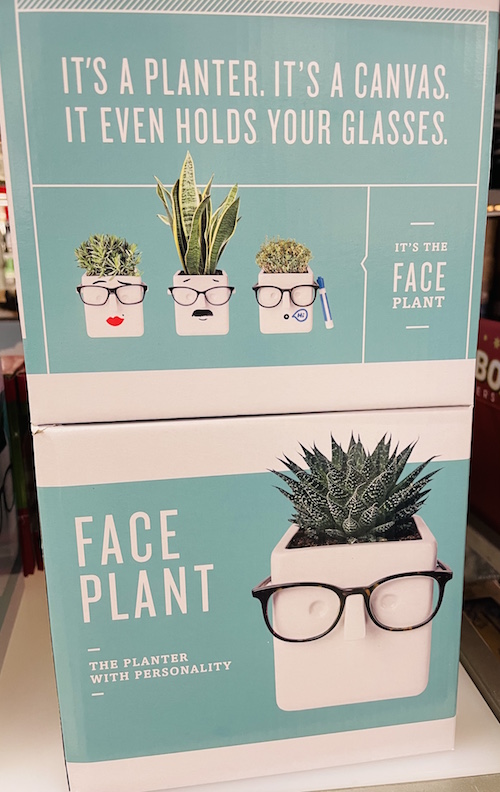
A stop at IKEA in Atlanta was so productive for organizing tools that you’ll be seeing posts with nifty names like Övning (for tidying a child’s desk accessories and creating privacy), Kugsfors (wall-mounted shelves with tablet stands for keeping books and iPads visible while working), Bekant (sit/stand desks) and more.
ORGANIZING YOUR FINANCIAL & LEGAL LIFE
Not everything in the organizing and productivity world is fun to look at, and that’s especially true of all the financial and legal documents that help you sleep soundly at night. Still, Paper Doll kept you aware of how to understand and protect your money, your identity, and your legacy.
Speaking of which, if you haven’t created your Apple Legacy Contact and your Google Inactive Account Manager, why the heck not? Use the power of body doubling up above, grab a partner, and get your digital life in order!
Lost & Found: Recover Unclaimed Money, Property, and Savings Bonds
Paper Doll’s Ultimate Guide to Legally Changing Your Name
Paper Doll Explains Digital Social Legacy Account Management
How to Create Your Apple & Google Legacy Contacts
Paper Doll Explains Your Health Insurance Explanation of Benefits
DEALING WITH EMERGENCIES AND STRESSFUL SITUATIONS
Sometimes, I write a post I wish I’d been able to read earlier (like the one on preventing and recovering from a car theft). Other times, like when a friend had a health emergency, or when Paper Mommy had her fall in November, I’m glad the posts already exist. If you missed these the first time around, please be sure to read, share, and bookmark them; think of them as an insurance policy, and let’s hope you won’t need them.
How to Organize Support for Patients and Families in Need
Organize to Prevent (or Recover From) a Car Theft
Paper Doll Organizes You To Prepare for an Emergency
GRAB BACK OF INTERVIEWS, UPDATES, AND PHILOSOPHY
Paper Doll Interviews Motivational Wordsmith Kara Cutruzzula
You already know how beloved my friend Kara Cutruzzula‘s Brass Ring Daily newsletter and Do It Today podcast are at Paper Doll HQ.
After having read and enjoyed Kara’s Do It For Yourself — A Motivational Journal and her follow-up, Do It Today — A Motivational Journal (Start Before Your Ready), I had no doubt that I’d be jumping on her third when it was released in September.
If you haven’t already picked up Do It Or Don’t — A Boundary-Creating Journal, use that Amazon money you almost certainly got this holiday season!
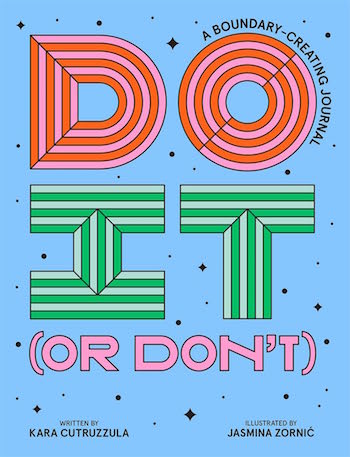 One of the Paper Doll themes for 2024 will focus on setting (and maintaining) better boundaries to accomplish more of what’s meaningful, and I’ve got multi-color tape flags sticking out of Kara’s book from all the chapters to share her bounty with you.
One of the Paper Doll themes for 2024 will focus on setting (and maintaining) better boundaries to accomplish more of what’s meaningful, and I’ve got multi-color tape flags sticking out of Kara’s book from all the chapters to share her bounty with you.
What’s in a Name? “Addressing” Organizing and Productivity
Paper Doll Suggests What to Watch to Get More Organized and Productive — As we head into the new year, I’ll be keeping my eyes open for podcasts, webinars, and TV shows to help you keep your space organized, your time productive, your finances orderly, and your life joyous. Readers have been sending in YouTube and TikTok videos that inspire them, so please feel free to share programming that you’d like to see profiled on Paper Doll‘s pages.
Paper Doll on How to Celebrate Organizing and Productivity with Friends
Paper Doll and Friends Cross an Ocean for Fine Productivity Conversations
From in-person get togethers with frolleagues (what my accountability partner Dr. Melissa Gratias calls those special folks who are both friends and colleagues) to Friday night professional organizer Zooms, accountability calls, and Mastermind group collaborations, this has been a great year for staying connected and sharing the benefits of those conversations with you.
I also loved guesting on so many fun podcasts related to organizing, productivity, technology, and more. If there’s someone you’d like to hear me debate or banter with, let me know!
SEASONAL POSTS
Spooky Clutter: Fears that Keep You from Getting Organized
Paper Doll’s Thanksgiving Week Organizing and Productivity Buffet
Paper Doll De-Stresses Your December
Paper Doll on Clutter-Free Gifts and How to Make Gift Cards Make Sense
Are you stressed out because you haven’t gotten someone a gift yet? Maybe a good start would be to help an overwhelmed special someone take my advice about going on a travel break. Consider gift certificates for something like Get Your Guide, with opportunities to get guided tours of locally-vetted, expertly-curated sporting, nature, cultural, and food experiences. With 118,000 experiences in 150 countries, pick a multiple of $50 or set your own amount, and your recipient can pick the domestic or international travel experience that fits best.
If you know your recipient will be traveling by rail, consider a gift card for Amtrak or ViaRail in North America. Eurail doesn’t sell gift cards, but you can pay for a pass, or buy a gift card for a rail pass for more than a dozen specific European train lines. And if you’d like to help someone organize vacation serenity and secure a bundle of travel attractions for a given city, try TurboPass in Europe or City Pass and The Sightseeing Pass in North America.
HERE’S TO A MORE ORGANIZED AND PRODUCTIVE 2024
Whether you’ll be spending the next few days reading, traveling, or doing your annual review, I hope this last week of 2023 is a happy and healthy one.
To send you off for a cozy week, I’d like to share a Whamagaddon– and Mariah–free, retro 100-minute holiday playlist from the late 1930s through the early 1960s. It’s somehow easier to dismantle the tree and write thank-you notes to Guy Lombardo. (My favorite clocks in at 52:42 with “What Are You Doing New Year’s Eve?”)
Please let me know your favorite Paper Doll posts from this year, and I’ll meet you back here in 2024!
Toss Old Socks, Pack Away 2023, and Adjust Your Attitude for 2024

I don’t know about you, beloved readers, but 2023 has been a rollercoaster.
In January, someone rang my doorbell late at night to tell me they’d hit my car in the parking lot; in August, my car was stolen. And in November, just ten days before she was set to join us for Thanksgiving, Paper Mommy fell and fractured her pelvis in two places, and then developed pneumonia 48 hours later, and complications after that! (As of this weekend, she’s finally home and recovering.)
I’m a positive person, but when the TV ads promote stage productions of Annie and the music swells for “The Sun’ll Come Out Tomorrow,” I’ve been struck by a powerful urge to throw the remote through the screen.
Professionally, 2023 was a mixed bag. I’ve maintained and added wonderful clients to my roster, and had a dazzling variety of in-person and virtual speaking engagements. But I was also saddened when a cherished elderly client passed away, and I must confess to not having made any headway on a passion project I’d wanted to write.
This is the traditional time to look back and pack away the prior year and set the tone for the one to come.
Letting go of what’s awful or unnecessary comes as second nature to professional organizers; it’s almost therapy to us. For example, I’m not much for Black Friday, but I used the opportunity to replace almost all of my socks with snazzy new ones and jettisoned the old, sad ones. I’m ready for a new foundation, literally and figuratively.
Evaluating and state of a hosiery drawer and replacing all of hole-y socks is easier than doing a deep dive into how we’ve lived our lives over the past year and designing change for the coming one, but they are similarly life-affirming and necessary.
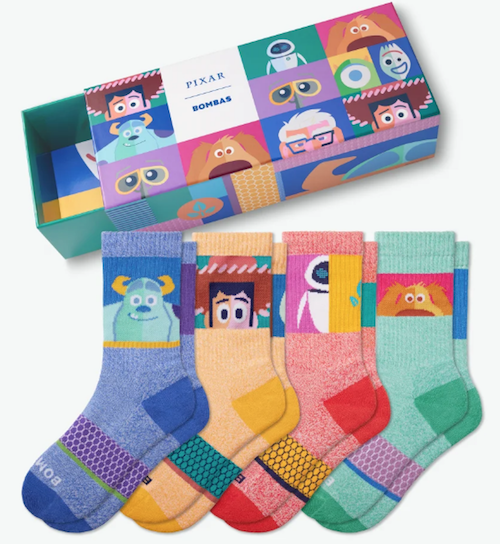
Editor’s Note: if you want to feel doubly-good about getting new socks, consider Bombas, which donates a pair to unhoused individuals for every pair you buy, or John and Hank Green’s Awesome Sock Club, where 100% of the profits go to a charitable organization working to decrease maternal and child mortality in Sierra Leone.
LOOK BACKWARD AND EMBRACE THE PERSONAL ANNUAL REVIEW
There are myriad ways to reflect on your past year, with multiple purposes. The main categories you might want to consider are:
- Health — Please don’t focus merely on weight, but consider stamina and strength, lab results, mental health, and health-related habits (both positive and unsavory).
If you don’t know how you’re doing in these areas, calling to make appointments with specialists and getting a handle on your numbers and benchmarks is a good place to start in the new year.
Don’t have a primary care provider or dentist or OB/GYN? Behind on your immunizations or age-appropriate health screenings like mammograms or colonoscopies? Make 2024 the year to catch up on your adulting! (In 2022, I finally got my overdue tetanus booster, an important one for professional organizers. We never know when something sharp is going to jump out and bite us!)
- Finances — Your bank balance doesn’t tell the whole story.
Did you stay within your budget? (Do you actually have a budget?) Are you comfortable with your rate of savings over the past year? Did you make good or bad investments (or avoid signing up for that 401K at work because you didn’t understand how it worked)?
Is your credit score trending up or down? Are there mistakes on your credit reports, or have you not even checked AnnualCreditReport.com since before the pandemic…or ever?
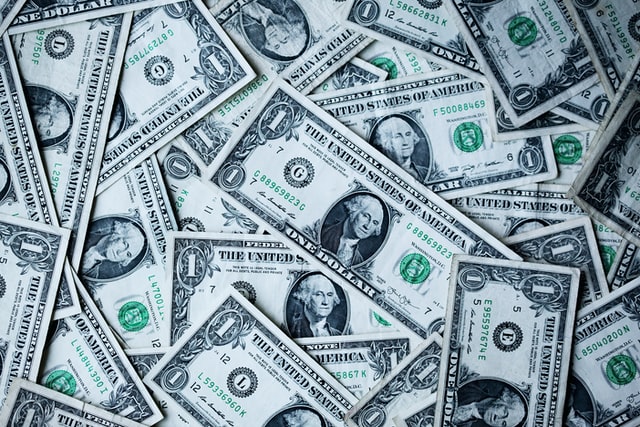
Dollars Photo by Alexander Grey on Unsplash
- Professional Development — If you work for someone else, prepare for your company‘s annual review (likely done on your work anniversary) by asking:
- What were the top projects I worked on this year in terms of financial return or impact? Am I happy with my contributions? Did I meet expectations? Exceed them?
- What achievement am I most proud of? Where did I fail to hit the mark of expectations, either my own or the company’s?
- What do I wish I had known or done earlier in the year to have improved my performance? What training, skills, knowledge, resources, or support do I need to make my performance next year better?
- Business — If you own your own company, business development means all of the professional development category, plus a much more detailed analysis. Look at all of your goals, not only to see if you achieved them, but to understand how you can improve their specificity, measurability or relevance the next time around.
Do you know where your clients or customers came from? Do you know how satisfied they are with your service or products? What are your metrics for sales, followers on your social media platforms (and interactions with those followers), newsletter subscribers, and your standing in the community?
Competition doesn’t matter as much as client satisfaction, but neither matter if you have no idea how your company (of one employee or one thousand) is trending.
- Relationships — Nobody can tell you what your relationships should be, but if you’re not feeling loved and supported most of the time in your interactions with your partner, family, and friends, it probably won’t get better on its own. Organizing relationships matters!
Identify areas of improvement, like better communication or ways to nurture one another and connect. Maybe you just need to cook and eat meals together, which a recent study has found leads to well-being.
Perhaps you need to consider whether this relationship has outworn its welcome. Just as with clutter, people buy into the sunk-cost fallacy; instead of throwing good money (or time) after bad — whether it’s an outgrown/defective car, gadget, or relationship — sometimes the best thing we can do is break free of inertia and let it go! (Cue Frozen!)
- Intellect and Education — What did you learn in 2023? What did you read or listen to that made you better at what you do or in terms of who you are? Students get report cards; as adults, it’s harder to evaluate our intellectual growth.
Try writing reviews of the books you read or tracking them in a notebook, or online in an app like Goodreads. (With only two weeks to go, I doubt I will hit my Goodreads Challenge goal of 39 books this year; I’m at 28 and will probably only finish two or three more. But that’s probably more than I’d finish if I didn’t keep track.)
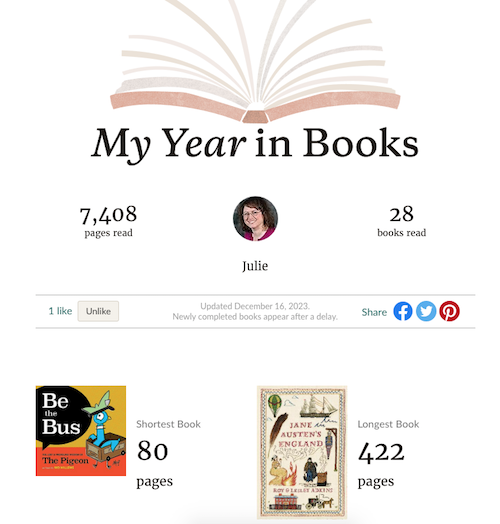
- Personal Growth — What’s different about you now versus last January? Have you grown in any way that’s discernible to your others or yourself? Did you embrace any new hobbies or skills?
If you’re happy with your life, huzzah! But if you feel like there was something missing in 2023, or if you participated in activities that no longer float your boat, now’s the time to explore and set some goals with actionable benchmarks for enriching your life. Make time for hobbies and passionate pursuits, and make room in your schedule for serendipity to offer you surprises!
- Community — Do you have a community outside of your work? Whether it’s social, political, charitable, spiritual, or otherwise, do you feel like you were involved in something bigger than yourself this year? How (and with whom) do you want to move forward next year?
WHAT TO DO WITH WHAT YOU LEARN FROM YOUR ANNUAL REVIEW
Knowing how you did is only the first step. Next, focus on three activities: Celebrate, Acknowledge, and Grow!
Celebrate
When I worked in television, I had a wonderful general manager who used to say, “One ‘Aw, <bleep>!’ wipes out ten ‘Atta-boys!'”
While his salty statement was designed to address public perception, it also calls to mind that even if we celebrate our successes in the moment, when we sit down to evaluate how we’ve done, we tend to focus on our failures and our shortcomings. With the perspective of weeks and months, we can revisit the areas of our lives where we’ve done well (or at least we did better than circumstances might have otherwise allowed).
Go through your calendar, emails, and task lists and find the wins! And because we can be unreliable narrators of our own lives, ask your partner, closest friends, mastermind group, and/or colleagues. You may be delightfully surprised by the successes you’ve forgotten while focusing on the day-to-day or even the fumbles.
Acknowledge
Yes, we do fumble. At work, with our families, with our promises to ourselves. We fail to aspire by believing we cannot succeed in organizing our spaces or our time or our lives, or we aspire without realistic planning, writing checks our overwhelmed future selves can’t cash.
The point isn’t to get mired in where we’ve fallen short, but to cash in our reality checks, measure our ending points against our starting visions, giving ourselves credit and then acknowledging what we must do differently. Do we need new goals and aspirations, or do we need to seek professional help, comradeship/support, and different tools?
Grow
There is little point to looking back as a pure exercise unless we plan to sit on our laurels or self-flaggelate. Instead, we should use the knowledge of our past year to determine what we want our next year to reflect. Often misquoted or truncated, there’s an excellent quote by Dr. Maya Angelou:
“I did then what I knew how to do. Now that I know better, I do better.”
After evaluating your year, ask yourself how you want to do better. Do you really want to lose weight to hit an arbitrary number on the scale, or do you want to feel more comfortable and more confident in your clothes? Do you want to jump on the fitness trend everyone else is trying or do you want to explore something that fits your needs and workout style?
I recently learned that our ability to get off the floor by ourselves, without using our hands, is highly correlated with longevity. So, even though I start every year wishing I were good at yoga (and not both klutzy and bored to tears by it), for 2024, I’m looking at continuing my 10+K walks, getting back into Pilates, and exploring functional workouts designed to help improve stability and strength. I’m also giving myself a benchmark date by which if I haven’t gotten into a regular routine beyond walking, I’m going to hire a coach to guide me on functional aging skills.
If you aren’t happy about (or aren’t feeling informed on) your finances, start by gathering intelligence. Your credit cards likely have a dashboard that sorts your expenditures into categories you can evaluate, like restaurant service delivery or monthly fees for apps you’re no longer using. Look for “spend analyzer” or “year-end summary” on your financial account apps to note trends. If you’ve been using Mint as an independent financial dashboard, note that Intuit is suspending it and moving some (but not all) of its functions to Credit Karma, so you may need to find an alternative.
PICK YOUR ANNUAL REVIEW STYLE
I know from experience that I flounder when trying to do a free-form annual review, so over the years, I’ve embraced Year Compass, which I learned about from Janet Barclay. Year Compass is free, downloadable and fillable, printable PDF. (It’s available in translations to dozens of languages.)
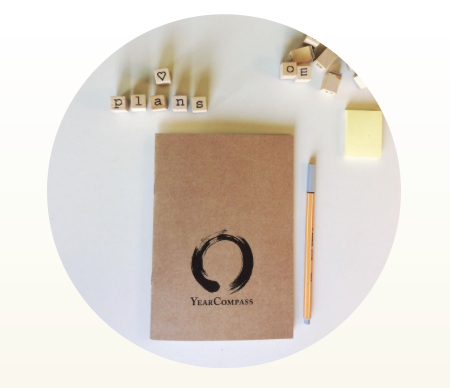
Just print the booklet version and fill it out by hand. (Be sure to set the page to US English to get North American paper measurements.) Alternatively, you can type your answers directly into the digital version. (My penmanship gets more unwieldy each year, but I think we all feel more connection to the past year’s version of ourselves if we hand-write responses.)
Explore the innovative questions to generate a thorough evaluation of how your past year turned out and how to approach the coming year. Do this on your own or with a group of friends or family after a yummy at-home brunch.
In last year’s post, Organize Your Annual Review & Mindset Blueprint for 2023, I talked about the importance of evaluating your year based on your personal values, as well quantitative and my own list of qualitative questions, which I’ll share again:
The Good
- What challenges made me feel smart, empowered, or proud of myself this year?
- What did I create?
- What positive relationships did I begin or nurture?
- Who brought delight to my life?
- Who stepped up or stepped forward for me?
- What was my biggest personal highlight or moment I’d like to relive?
- What was my biggest professional moment I’d want to appear in my bio?
- What’s a good habit I developed this year?
The Neutral
- What did I learn about myself and/or my work this year?
- What did I learn how to do this year?
- What did neglect or avoid doing out of fear or self-doubt?
- What did I take on that didn’t suit my goals or my abilities?
- What was I wrong about?
The Ugly
- What challenges made me feel weaker or less-than?
- Whom did I dread having to see or speak with this year?
- Who let me down?
- Whom did I let down?
- What did I do this year that embarrassed me (professionally or personally) or made me cringe?
- When did I hide my light under a bushel?
- What am I faking knowing how how do? — Instead of pretending you know how to do something but are choosing a different path, ask for help. Make decision about what to do from a position of strength rather than weakness.
- What’s a bad habit I regret taking up or continuing?
- Where did I spend my time wastefully or unproductively? (It’s social media. For all of us.)
- Where did I spend my money wastefully or unwisely? (Target? Let’s take a poll. Was it Target?)
WHY LOOK FORWARD?
Unless you’re a fourth grader watching the clock tick down until recess, time moves too quickly. We have little opportunity to savor the good, and before we know it, the years have flown by. If I don’t plan for how I want to live my future, time will go by without achieving what I want. To remind myself of the brevity and value of each day (without getting too maudlin), I use the simple but motivational app Life Clock.
Life Clock, available for iOS and Android, envisions a lifetime as the equivalent of a 24-hour clock. You feed it limited personal information and it extrapolates your life expectancy (though you can always adjust the number). It then identifies, for the given date, what “time” it is in your life.
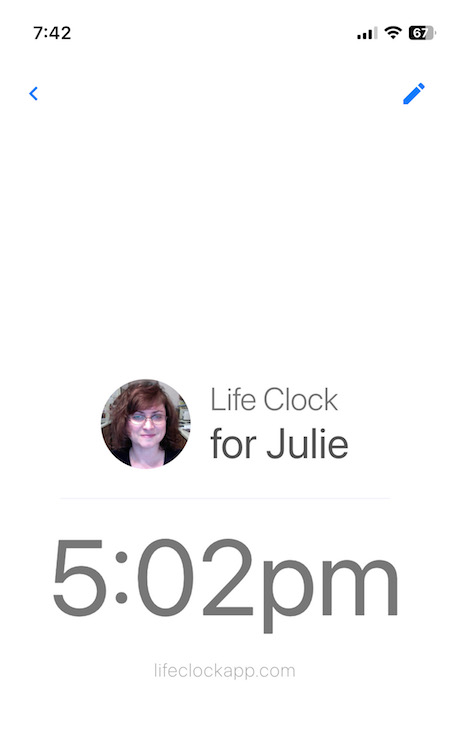
Gulp!
Life Clock shares mini-facts about how to extend your lifespan (and notes what shortens it), and details historical trends and where traditional benchmarks (like graduating and moving out of your family home) fit on the clock of life. Each minute of your “life clock” equals about 20 days in real life.
We don’t need to “optimize” every bit of our lives; we deserve downtime. But we only get 1440 minutes in a real day, so let’s not waste a single one of our life clock minutes on things that aren’t good for us and don’t make us happy.
Nobody gets to decide for you what matters most. That said, it’s hard to stay focused on what matters to you when kids and world events and who Taylor Swift is dating all get in the way.
RESOLVE TO GIVE UP RESOLUTIONS
As I’ve written for many years, I don’t think resolutions work; they lead to disappointment and frustration. Why?
- People set unrealistic expectations. Resolutions are often overly ambitious and fail to account for the time and effort you need.
- Not all goals have to be SMART goals, but if your resolutions lack specificity (“get out of debt” or “get it shape,”), you have no actionable steps to take.
- Most resolutions have no real plan of action and no method for achieving accountability.
- Far too many resolutions have no intrinsic motivation. If your resolutions are designed to make someone else happy (whether that’s your mother-in-law or society) or compete (with a societal ideal or another individual), you’re bound for misery. I prefer SMARTY goals that are specific, measurable, achievable, relevant, time-based, and most importantly, yours.
- Too many resolutions are made and evaluated with all-or-nothing thinking. Success based on perfectionism is demotivating. Give yourself grace.
Instead of resolutions, focus on changing your habits. I’ve written about this at length, including in Organize Your Life: The Truth About Resolutions, Goals, Habits, and Words of the Year back in 2019 and earlier this year in Paper Doll Helps You Find Your Ideal Analog Habit Tracker.
So read those two posts, and for real, meaningful change, read Charles Duhigg’s The Power of Habit: Why We Do What We Do in Life and Business
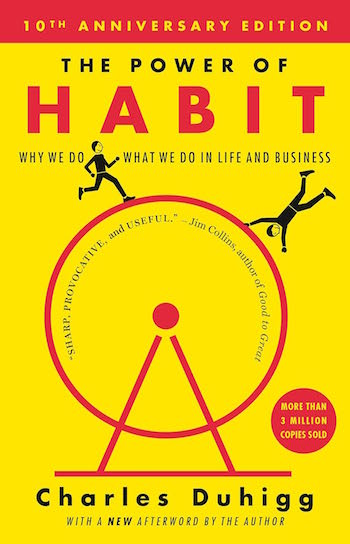
and James Clear’s Atomic Habits: An Easy & Proven Way to Build Good Habits & Break Bad Ones.
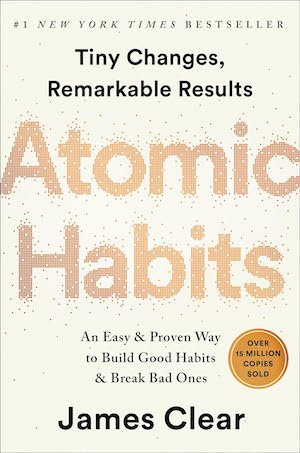
We don’t change who we are just because we decide to. We need a game plan. I will never embrace brevity in talking or writing. I will never be a morning person. But, I can change my habits. And so can you.
PROMOTE YOUR 2024 PLAN TO YOURSELF
Along with habit changes instead of resolutions, I believe in boosting your mindset so you can remind yourself, regularly, that you want to live a certain way, and why.
In the annual review/forward-looking posts I’ve linked to throughout this post, I’ve done deep dives into ways to keep the motivation and energy of your “why” alive. You can read about them in detail, but they include:
- a word of the year
- multiple words (like a trio of words) of the year
- a quote or motto or mantra of the year
- a song of the year
Whatever you pick, this word or phrase or song is your personal theme for the coming year. It reflects what you want to remember about your goals and your attitude. We all know that advertising works, so whatever you pick, or however you combine these ideas, use your (organized) space to keep your attention on your intention for the year.
Promote your theme word or phrase or song — to yourself — on a vision board to reflect and encompass any or all of your motivating words, phrases, and songs. Post your message to yourself on your bathroom mirror, your fridge, the inside of your front door — anywhere that it will give you a boost! Change your wakeup alarm on your phone to your song theme!
PAPER DOLL’S WORD OF THE YEAR FOR 2024
Some years, I do better than others with my word choice. In 2020, I picked “ample” and embracing the phrase “Ample: it’s not just for bosoms anymore.” I’ve carped about how the “ample” opportunities for experiencing a global health crisis weren’t appreciated, but upon years of reflection, I did grow the virtual organizing and productivity coaching side of my business.
2021’s “delighted” kept me seeking opportunities for delight, but I never managed to find a word that fit well for 2022. This year, I chose “fulfilled,” and it was a guiding principle behind work and life choices.
So far, I have two contenders for 2024.
One option came to me mid-summer in a flash, so I wrote it on the December page of my calendar so I wouldn’t forget. The word is UPGRADE.
I have a habit of overthinking a word’s unintentional implications. (Like how the year I picked “resilient,” I ended up with too many things from which to bounce back.)
Upgrade, though, has real potential. While there might be a slight implication of expense — having to replace things — I really feel the vibe of improvement. This isn’t about upgrading tangible things (socks notwithstanding) but about the quality of my experiences.
But “upgrade” has a quirky competitor: PRONOIA.
Don’t worry if you’ve never heard of it. Honestly, the first time I heard the word, I assumed it was made up. It’s opposite of paranoia; a person experiencing pronoia believes that the world around them conspires to do them good. Obviously, taken to extremes, it might seem like psychological or spiritual irrationality.
But Buddist principles haven’t been working for me, I’m still trying to get a handle on the Stoics I talked about in Toxic Productivity Part 2: How to Change Your Mindset. I feel the pull of a bigger change in my life, and I think “pronoia” dovetails with the idea of a life upgrade.
Thus, I keep coming back to the Carly Pearl song in which I first heard the word “pronoia.”
While song is about psyching oneself up after a heartbreak, there’s something in the lyrics (and Pearl’s intonations) that I find inspiring.
You ever heard the word Pronoia?
It’s the opposite of paranoia, pronoia
The belief that the world conspires in your favor
Honey, it’s a game changer
It’s a cherry lifesaver
When I feel like everything is breaking down
It’s the dip before I hit the higher ground
(©2023 Carly Pearl, Renee Hikari, and David Baron)
How do you feel about the year that’s ending? What word or phrase or song is emblematic of what you want in 2024?
Take a Break — How Breaks Improve Health and Productivity
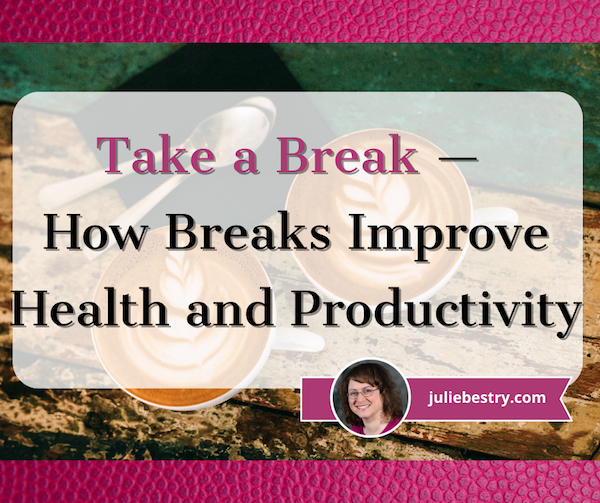
If I asked what the single best thing you could do to improve your productivity was, what would you say? Would it be doing a brain dump of your tasks? Prioritizing what you need to do? Making a list? Avoiding multi-tasking? Eliminating interruptions?
What would you think if I told you that the best way to get the most out of everything you are doing is to stop doing it for a little while?
I know, it may sound counterintuitive, but taking a break instead of spending your day trying to power through is exactly what’s needed for your body, your brain, and your spirit, not to mention the actual work.
It may sound counterintuitive, but taking a break instead of spending your day trying to power through is exactly what's needed for your body, your brain, and your spirit, not to mention the actual work. Click To TweetLet us not forget the trouble Alexander Hamilton found himself in when he failed to take a break. First, Eliza begged him to step away from his efforts to create a national banking system and pay attention to his son’s performance. (It’s a pity Lin-Manuel Miranda didn’t insert a verse from Cat’s In the Cradle!) Then his wife and sister-in-law begged him to “take a break,” and join them at their father’s place in upstate New York instead of struggling on in New York City.
(And, as fans of history and/or the musical Hamilton know, the failure to take a break from single-mindedly focusing on defeating Jefferson, et. al., and controlling the American economic future led, at least in part, to Hamilton making a poor personal decision (regarding Maria Reynolds), which led to others thinking he’d made a poor ethical and professional decision, which led to Hamilton blowing up his personal and professional lives. The whole second act is a testimonial for the vital importance of taking a break!)
But we don’t have to interpret musicals to know that taking breaks from our work or studying is essential for happy, productive lives. In “Give me a break!” A systematic review and meta-analysis on the efficacy of micro-breaks for increasing well-being and performance, researchers analyzed the results of 22 independent studies on the efficacy of work breaks for “enhancing well-being (vigor and fatigue) and performance.” They found that breaks were essential for replenishing mental and physical energy after work-related depletion, and that the more depleting a task is, the longer a duration of break is needed.
And if neither musical arts nor academic research is enough to convince you, how about the effect, not only on workers, but on work? Eight years ago, an NPR piece, We’re Not Taking Enough Lunch Breaks. Why That’s Bad For Business, noted that only one in five people were stepping out of the office at lunchtime. The point wasn’t eating at work, but not stepping away from work. As we’ll see, that undermines our bodies, our minds, and the quality of the work we perform.
WHAT COUNTS AS A BREAK?
A break can be of varying durations for varying activities. How long does a break need to be to have a positive effect? That depends on the work you’re doing, how much energy it depletes, and the kind of break you’re taking.
How to Take Better Breaks at Work, According to Research from the Harvard Business Review, notes that shorter breaks can be effective but that the timing of breaks is also vital. For example, because fatigue intensifies as the day goes on, short (or at least shorter) breaks are more effective in the morning, but by late afternoon, longer breaks are necessary to yield positive results.
So, what length breaks should we consider?
20–20–20 Rule
This rule simply instructs that every twenty minutes of screen time, look away from the screen and focus on something at least twenty feet away for at least twenty seconds.
The 20–20–20 Rule is designed to prevent computer vision syndrome, particularly digitally-induced eye strain. Taking a break like this can also help reduce blurred vision, headaches, dry eyes, and neck and shoulder pain.
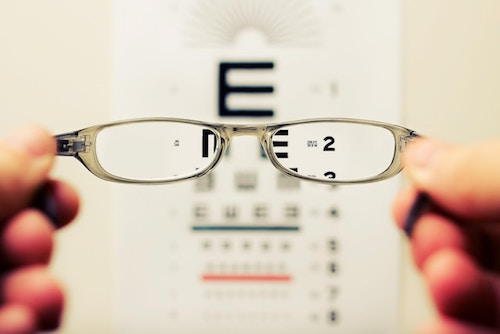
Eye Chart Photo by David Travis on Unsplash
Regular screen breaks of just one-third of a minute will give your baby blues (or browns or greens) much-needed rest, but maybe more. When something (like a phone alarm or alert on your screen telling you, “Look away! Look away!”) prompts you to take this momentary break for your vision, you’re likely to adjust more than your eyesight.
When you’ve been in flow, focused intently on what you’re reading on the screen, you’ve probably failed to pay attention to your posture (so you maybe slumped forward toward your screen) and your breathing. This super-quick break shakes everything loose.
Short Breaks
A short break would be anything that takes less than 5 or ten minutes. Consider the break you might take when doing a series of Pomodoros, where you work for 25 minutes, then step away from the task at hand — and step away from your desk — to stretch, spend a few minutes on a puzzle, or play with your puppy.
Moderate Breaks
These are the kind we’ll be looking at in great detail over this post and the next one. There’s quite a bit of cross-over between the breaks that primarily help reset the body vs. the brain, but in broad strokes, these categories might include:
Breaks primarily for the body
- Meal and snack breaks — Working through lunch is so bad for your physical and mental health that France outlawed eating at your desk all the way back in 1894! It’s called la pause déjeuner, and granted, it was for hygienic reasons, but now it’s recognized as good mental hygiene to step away to eat lunch mid-day and onboard some healthy(ish) snacks to energize the body, concentration, and focus.
- Nap breaks — Sure, not everyone is physically (or socially) able to take a power nap, but these mini-sleepytimes can pump up our energy and improve our ability to concentrate. In the US, this is more likely to be your jam if you work from home, unless your company has invested in nap pods, but there are many cultures where a nap break is considered part of the work day.
- Walk breaks — Personally, nothing allows me to refresh my brain as well as getting my 10,000+ steps. While the prescription for 10K steps was made up by a Japanese pedometer company (and your personal peak number of steps depends on age and health), there’s something magical about pounding the pavement (or the lawn or the forest). Each successive step seems to clear mental fog; if I take a walk break when I’m facing a work problem (like how to tackle a blog post), the solution comes to me by the time my walk break is over.
- Dance breaks — Pump up the jam! The advent of personal surround-sound means you can listen to music without Lloyd Dobbler standing outside your bedroom, hoisting a boom box playing “In Your Eyes” over his head. If you work alone, blast your tunes; otherwise, put on those Beats or Airpods, and play on your favorite song to make your own music video.
Find a conference room or classroom where nobody’s likely to disturb you, or head out behind the building, and shake your groove thang! Consider these suggestions for finding your go-do dance-along video:
Breaks primarily for the brain
- Meditation and mindfulness breaks — An entire industry has popped up for helping people take breaks to be mindful and/or meditate. Some popular free apps include:
- Insight Timer
- UCLA Mindful
- Healthy Minds Program
- Smiling Mind
- Mindfulness Coach (developed by the US Department of Veteran’s Affairs to help combat PTSD)
Additionally, there are a variety of guided meditations on YouTube. For example:
Whether you aim for more formal guided meditations or gentle mindfulness activities like deep breathing, you’ll find that this kind of break can reduce your stress when you feel like you’re constantly tumbling <bleep>-over-teakettle.
- Nature breaks — I’m probably the last person to think about communing with nature. I hate wind and rain and bugs and heat and the sound of frogs and crickets. I am generally an in-of-doors girl. But the Japanese practice of “forest bathing” (Shinrin-yoku) has been found to reduce blood pressure, alleviate depression, improve mental health, boost immune function, and more. Beyond that, getting away from your computer and focusing your eyeballs (and the rest of your sensory receptors) on something other than work will recharge the body and the brain, making the return to work more inviting.
And even I can find ways to enjoy nature! This past weekend, my friend and colleague Sara Skillen and I drove from our respective cities to meet at Sewanee — University of the South for lunch and a bit of a meander.
I love exploring college campus architecture, and we were both excited to walk the labyrinth in Abbo’s Alley, acres of campus with forest/woods, streams, stone bridges, a butterfly garden, gazebo, and other goodies.
We spent over an hour in search of the labyrinth (not even shown in the calming video, above), ambling (and occasionally tripping) over tree roots and wobbly rocks. However, the combination of Sara’s stellar company, perfect temperatures, and the lack of bugs made our jaunt an ideal break from the typical workweek.
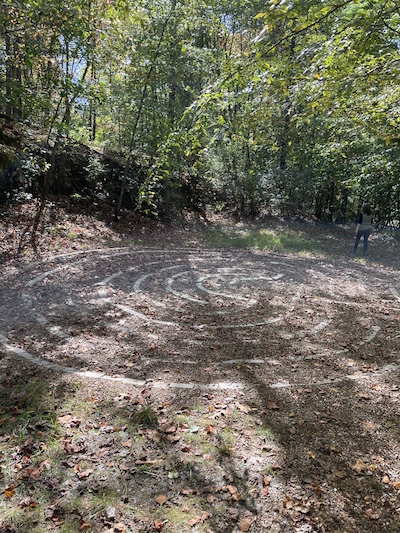
The intriguing thing is that taking a break to “touch grass” works even if you’re not walking or otherwise moving around enough to pump your blood; just sitting outside, even if your “outside” isn’t at all what most people would think of as “nature,” can still have a calming effect.
- Creativity breaks — Even if your workday involves creating, a creativity break can blow that layer of dust off of your mental capacity. You can’t usually step away from work to spend half a day creating, but you can blend your lunch break with some time for painting, drawing, playing a musical instrument, or journaling (by hand, if possible).
- Appreciation breaks — Not every break requires producing something. Sometimes, when your brain is full of one thing, the solution is to fill it with something else, particularly something serene or delightful. Consider taking your lunch break at a nearby museum or art gallery, or just watch tiny humans playing in the park. Appreciate the elegance of ducks swimming on a pond or enjoy the colors and sounds of an open air market.
- Social breaks — While reading social media has downsides, being social does not. I’m an extrovert, and there’s nothing that pumps me up more than taking a break to socialize. Of course, if you’re an introvert, you may not want to wade into loud, involved conversations with colleagues (or, heaven-forbid, strangers), because it may drain you of the mental energy you’re aiming to refresh.
Whatever kind of break you take from daily work, select types of activities that will use different aspects of your brain than you were using to write reports, design web sites, study economics, etc. This allows the “part” of the brain that was overworked to rest and re-set.
Full-Length Breaks: Vacations
I could (and probably should) write a post about the mental, physical, and productivity benefits for taking a long break, whether that’s a real weekend without looking at email or a two-week immersive vacation. Of course, not everyone gets paid vacation, but vacation-length breaks are essential to our health and vigor, which in turn, keep us productive, whether that means making the widgets to building society by raising a family (or, as is often the case, both).
THE BENEFITS OF TAKING A BREAK
When we take breaks throughout the workday, we reap the benefits of better overall physical and mental health, enhanced cognitive function, and improved job performance, all of which will improve our productivity. Let’s look at some of the key advantages of incorporating regular breaks in your work routine.
Enhanced Physical Health
When we incorporate any breaks in our day that involve physical activity or movement, whether it’s stretching, walking, or exercise, it contributes to improved physical health. We improve the blood circulation throughout our bodies (including to our brains!) while reducing the muscle tension that leads to headaches, body strain, and repetitive stress disorders like carpal tunnel syndrome.
We also prevent the various negative health effects of prolonged sedentary behavior. I’m sure you’ve heard the expression, “Sitting is the new smoking.” As I explained in Paper Doll on The Truth(s) About Standing Desks, it’s not that standing desks are that much better. Sitting is bad because when you sit all day, your telomeres (the tiny caps on the ends of DNA strands) get shorter, and the rate at which the body ages and decays speeds up. However, standing all day (like at a standing desk) isn’t necessary all that much better. What is important is movement, and you generally have to take a break from work to get moving!
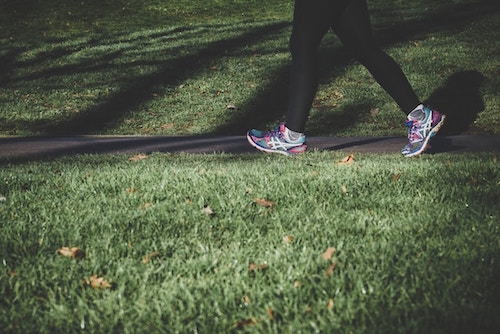
Walking Photo by Arek Adeoye on Unsplash
Stress Reduction
Varying reports note that workplace-related stress affects up to 80% of American workers. That’s estimated to cost anywhere from $150 billion to $300 billion. That economy-busting stress isn’t going to disappear if we add a few extra breaks each day for mental clarity, but we can turn this around on a personal level.
Breaks in our workday give us the opportunity to reduce stress levels and alleviate the pressure of constantly being focused on work (and the related external expectations place on us). When we engage in any kind of activity that promotes relaxation, we can lower blood pressure (which is good for both the body and the psyche), improve mood, and enhance a sense of well-being.
When we think about stress-reduction activities, we often focus on time-intensive tasks, like a yoga class or long hike, but short-term activities like mindfulness exercises, deep breathing, and brief walks (around the building or around the block) can have similar mental health benefits for reducing stress.
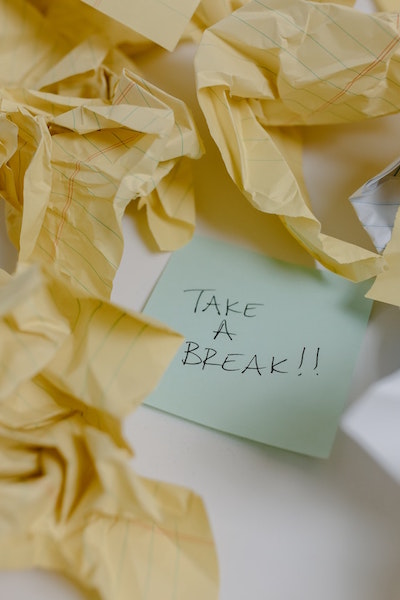
Take a Break Photo by Tara Winstead
Increased Energy and Motivation
When we take breaks throughout the workday, the physical and mental health benefits described above will have a domino effect, knocking down (and out) other problems.
When we take stop what we’re working on to eat, nap, socialize, exercise, or just remove ourselves from hyper-focus on our work, we replenish our energy, both our physical capacity (with improved blood pressure and balanced blood glucose levels) but also our mental capacity.
Conversely, if we don’t take breaks, we’re more likely to suffer from burnout. A 2022 study from Aflac found that 59% of workers were experiencing burnout, and 86% of those reported experiencing anxiety, depression, and sleep difficulties in the prior year, so this is not a negligible concern.
Setting aside time for physical movement, relaxation, and self-care boosts our sense of well-being, which tops off our enthusiasm, and in turn, that improved motivation boosts our ability to perform and sustain our productivity. Whoohoo!
Improved Focus, Memory, Concentration
Contrary to our assumptions that we should always power through our work, our brains need novelty. Researchers at the University of Illinois found that the longer we focus on something, the more likely the occurrence of a “vigilance decrement,” where our “attentional resources” start to plummet. It’s like how we are aware of how cold the ocean is when we jump in, but the longer we’re exposed, the more we get used to it. Or, to use a clichéd metaphor, we’re the frog in the boiling water.
Our brains respond to change, and the longer we go without change, the less efficient they are. Breaks don’t just rev us up; they help prevent the mental fatigue that sets in when we’ve tried to work too hard or too long. When we get lost in those mid-afternoon cobwebs, a break can enhance concentration, allowing the brain to rest and recharge.
Periods of mental rest, whether through mindfulness, activity, or sleep have the power to help us consolidate our memories and improve learning. And this is all as true for kids as for adults!
Short break periods jazz our bodies. We might imagine that a vigorous walk or dancing around to Taylor Swift would pump too much blood to our brains, making it hard to focus, but the opposite is true. Relaxation, whether it’s arrived at through calming activities like meditation or energizing ones like physical activity, will boost cognitive resources. In turn, it enables people to improve and maintain attention, allowing more effective and efficient focus on the work at hand!
Prevention of Decision Fatigue
Decision fatigue occurs when we are faced with too many overwhelming choices without adequate rest, whether for our bodies or our brains. However, breaks can play a crucial role in preventing decision fatigue; just a short pause for the right kind of physical or mental stimulation and/or relaxation can reset cognitive resources.
When we have decision fatigue, we may make poor choices, or procrastinate on making any choices at all. Breaks can give us the resilience to make better decisions and maintain a higher level of productivity, using those decisions to move our projects forward.
Enhanced Creativity and Problem-Solving
We all know what it feels like when our brains get stale. We cease coming up with fresh takes (or even fresh words), which turns into a vicious cycle. If we’re not feeling creative and can’t solve our problems, we’re going to feel bored, unenthusiastic, and stressed out!
Taking breaks fosters divergent thinking and spikes creativity, so we can approach tasks from fresh perspectives. Just stepping away from work for a short time — and focusing on the right energy-boosting replacement tasks — can stimulate more innovative ideas and solutions, improving our problem-solving skills and pumping up our creative mojo.
Per the NPR piece I quoted earlier, Kimberly Elsbach (a Professor Emerita Fellow, Academy of Management University at the California Davis Graduate School of Management), an expert in workplace psychology, noted that never leaving your office or your desk is “…really detrimental to creative thinking. It’s also detrimental to doing that rumination that’s needed for ideas to percolate and gestate and allow a person to arrive at an ‘aha’ moment.” Aha, indeed!
It’s essential to recognize the positive impact of breaks on physical, mental, and emotional well-being so that we can remember to prioritize these pauses and integrate them into our daily work routines. This is key to us fostering balanced, productive approaches to taking on our responsibilities.
Not all breaks are created equal
Pausing work to scroll through social media won’t have the same benefits as the kinds of breaks discussed earlier in this post. First, everything from the death-grip on our phones to the poor posture of arching necks over screens to the blue light of cell phones is bad for physical health; plus, you’re likely to remain just as stationary as when you were working! Beyond that, social media rarely reflects the kind of psychologically neutral or uplifting content that boosts mood or cognition.
Similarly, smoke breaks aren’t good breaks. While they may yield some social benefit, data on smoking’s physical devastation on the body and brain is clear. Moreover, research finds that smokers have thinner cerebral cortex than non-smokers. (The cerebral cortex is essential for learning and memory, so thicker tissue is better.) Smoking reduces the ability to learn and remember, key requirements for productivity!
TAKE A READING BREAK
For further reading on the importance of breaks for health and productivity, you may wish to read:
Breaks During the Workday (Michigan State University)
Give Us a Break (Compass Group)
How to Take Better Breaks at Work, According to Research (Harvard Business Review)
BETTER BREAKS AROUND THE WORLD
In full disclosure, this post started out as a look at how other cultures embrace taking breaks as part of coping with excessive workloads. Instead, this is the prequel, a what-and-why for improving your vitality and productivity with breaks. Next week’s follow-up post, Take a Break for Productivity: the International Perspective is where the real fun will be, as we look at fun and tasty examples of “take a break” culture around the world.
Spoilers: the Swedes take the cake (figuratively and literally) and first place when it comes to taking breaks!


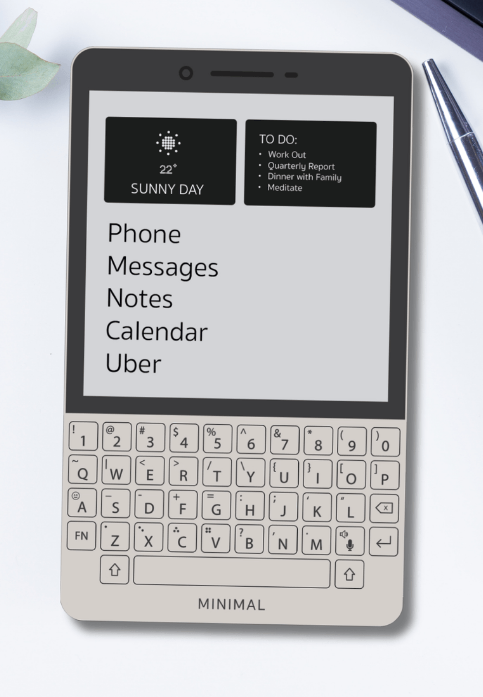





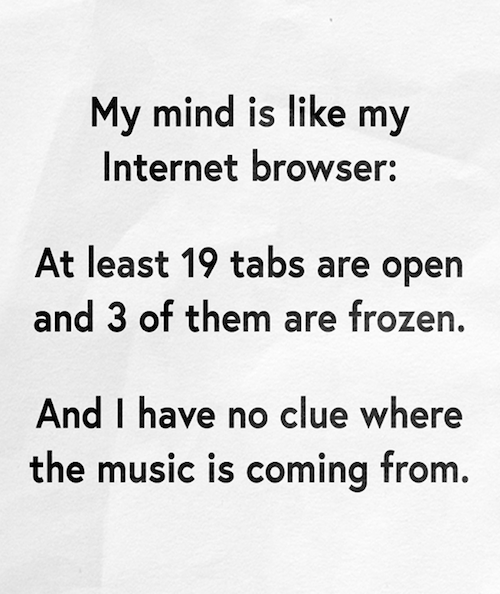
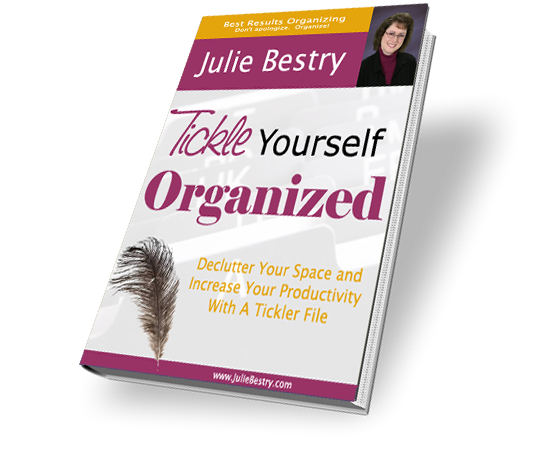






Follow Me